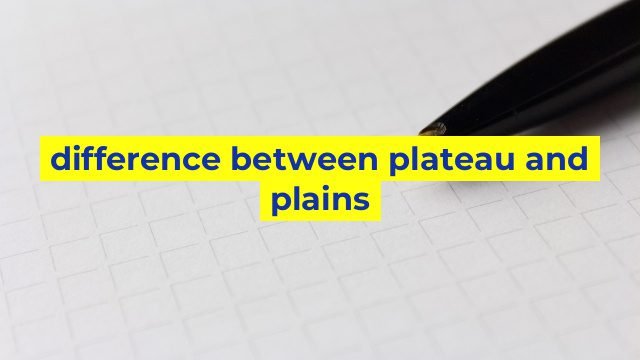The Difference between Plateau and Plains: Explained
The terms plateau and plains are commonly used when referring to topographical features, but what exactly do they mean? Although they may seem similar, there are distinct differences between the two. In this article, we will delve deeper into their unique characteristics and compare them.
What is a Plateau?
A plateau is an elevated area of land that is flat at the top. It is usually situated between mountains or hills and is often formed due to volcanic activity or tectonic uplift. Plateaus can range from small tablelands to enormous territories covering thousands of square miles. They are often found in arid or semi-arid regions, and their elevation can lead to significant variations in climate, vegetation, and wildlife.
One of the essential features of plateaus is their steep slopes, which can create stunning landscapes and challenging terrain for exploration. Some famous examples of plateaus include the Tibetan Plateau in Asia, the Deccan Plateau in India, and the Columbia Plateau in the United States.
What are Plains?
Plains, on the other hand, are relatively flat areas of land that are characterized by low relief and gentle slopes. Plains can be found in various regions worldwide, including coastal regions, river valleys, and deserts. They are formed by natural forces such as erosion, glaciation, and deposition over millions of years.
Unlike plateaus, plains have a more uniform elevation, creating ideal landscapes for agriculture and human settlements. They are also known for their excellent transportation systems, as they provide smooth and level ground for the construction of roads and railways. The Great Plains of North America, the Pampas in South America, and the Eurasian Steppe are some of the world’s most massive plains.
Differences between Plateau and Plains
The primary difference between a plateau and plains is the elevation and topographical features. The former is elevated with steep slopes, while the latter is relatively flat, with a gentle gradient. Additionally, plateau regions have more varied vegetation and animal life than plain regions. Plateaus are also not suitable for farming due to their harsh climates, while plains are often cultivated for agriculture.
In conclusion, plateaus and plains are two unique types of landforms with distinct features and characteristics. Plateaus tend to be elevated areas with steep slopes, and they are often found in arid or semi-arid regions. Plains, on the other hand, are flat areas with low elevations and are ideal for agriculture and transportation systems. Understanding these differences is essential to appreciate the beauty and value of our planet’s natural landscapes.
Table difference between plateau and plains
Plateau vs Plains
| Plateau | Plains |
|---|---|
| A highland area | A lowland area |
| Raised above the surrounding area | Generally flat with little or no elevation |
| Steep slopes and cliffs on the edges | Smooth and gentle slopes |
| The top is flat | The top is not flat, it curves with the Earth’s surface |
| Created by either tectonic uplift or volcanic activity | Created by sediment deposition or erosion of existing landforms |
| Example: Tibetan Plateau | Example: Great Plains of North America |
